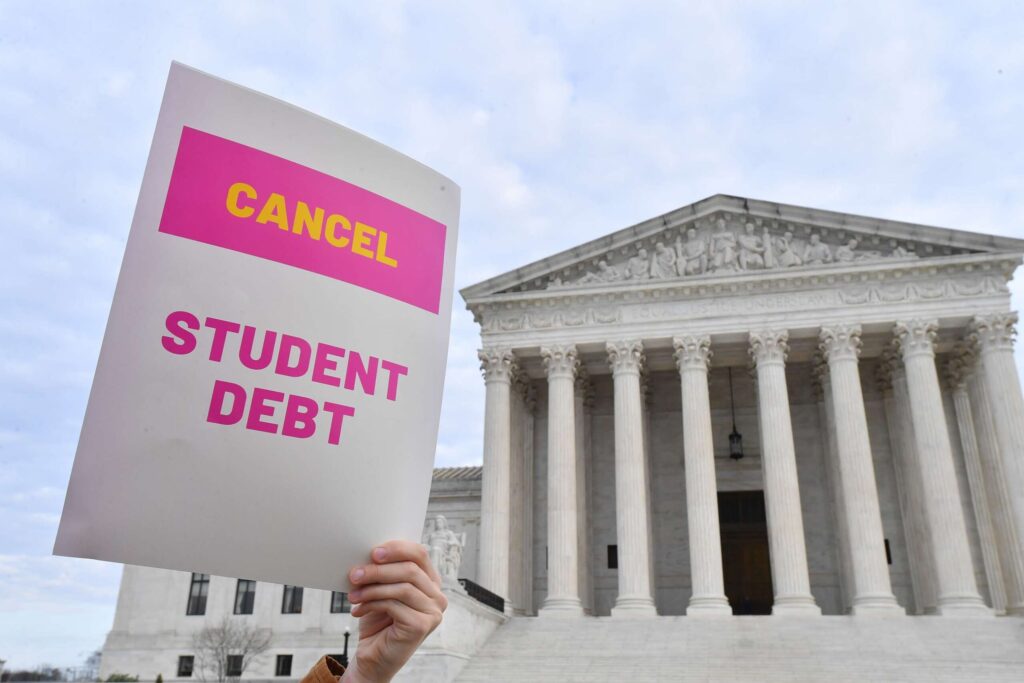The student debt crisis in America has reached unprecedented levels, with total outstanding student loan debt surpassing $1.75 trillion in 2022. This enormous debt burden is saddling millions of Americans with payments and interest that take years to pay off, if ever.
In August 2022, President Biden announced a plan to provide substantial student loan forgiveness to help relieve this crisis. Biden’s loan forgiveness plan will cancel up to $10,000 in federal student loan debt for individuals earning under $125,000 a year, and up to $20,000 for Pell grant recipients under the same income cap. This forgiveness applies to federal loans only, so private student loans are not eligible.
Biden’s aim with this historic proposal is to lessen the crushing student debt burden for millions of Americans. With the rising costs of college and stagnant wages, student loans have become crippling for many borrowers. This loan cancellation offers an opportunity for a fresh start and financial relief, although some economists argue it may fuel inflation. The plan faces legal challenges as well. Overall, Biden’s loan forgiveness program represents a major attempt to ease the student debt crisis, but its long-term impacts remain uncertain.
Eligibility Requirements
To be eligible for federal student loan forgiveness under Biden’s plan, borrowers must meet certain criteria. The eligibility requirements are based on income thresholds and the types of federal loans held.
Income Levels
-
Borrowers who earned less than $125,000 (or $250,000 for married couples) in either 2020 or 2021 will be eligible for up to $10,000 in forgiveness.
-
Borrowers who received a Pell Grant in college and meet the income criteria above will be eligible for up to $20,000 in forgiveness.
-
There are no eligibility requirements related to income for borrowers who earn more than those threshold amounts.
Federal Loan Types
Only federal student loans are eligible for forgiveness under this plan. This includes:
- Direct Loans (defaulted and non defaulted)
- Federal Family Education Loan (FFEL) Program loans held by ED (defaulted and non defaulted)
- Federal Perkins Loans held by ED (defaulted and non defaulted)
Federal student loans that are eligible for this one-time debt relief include: undergraduate loans, graduate loans, spousal loans, and consolidation loans.
Private student loans are not eligible.
Loan Status
To qualify, the federal student loans must have been originated prior to July 1, 2022. This includes loans made before this date that have been consolidated.
Borrowers must have qualifying loans that are still outstanding. Loans that are paid off or forgiven through other programs are not eligible.
The loans cannot be in default status to qualify for forgiveness. Borrowers with federal student loans in default are required to bring their account current before becoming eligible.
Application Process
Applying for student loan forgiveness under Biden’s plan is a straightforward process. The application will be available on the Federal Student Aid website once the program launches.
To apply, you’ll need to provide some basic information including:
- Name
- Date of birth
- Social Security number
- Contact information
- Employer information (if applying based on your income)
You’ll also need to agree to provide proof of income if requested. This can include tax returns, W-2s, or pay stubs.
The application is expected to go live in early October 2022. You will have until December 31, 2023 to submit your application.
It’s important to apply as soon as possible once the application is available. Funds are limited and loan forgiveness will be granted on a first-come, first-served basis. Applying right away ensures you get in line early for forgiveness before funds potentially run out.
The application process should take 5-10 minutes to complete. You’ll be asked to electronically sign the application affirming that all information provided is accurate.
It may take several weeks or months to receive a final determination on forgiveness. The Department of Education will continue notifying borrowers if they qualify through the end of 2023.
Forgiveness Amounts
The Biden administration’s student loan forgiveness plan provides up to $10,000 in relief for non-Pell grant recipients, and up to $20,000 in relief for Pell grant recipients.
There are differences in forgiveness amounts for undergraduate vs graduate student loans:
-
For undergraduates, up to $10,000 in student loan forgiveness is available for non-Pell grant recipients, and up to $20,000 for Pell grant recipients.
-
For graduates, the forgiveness amounts are the same regardless of Pell grant status – up to $10,000 in forgiveness for all graduate student loan borrowers.
So in summary, undergraduates who received Pell grants while in college are eligible. For more forgiveness ($20,000 max) than undergraduates who did not receive Pell grants ($10,000 max). All graduate student borrowers are eligible for up to $10,000 in forgiveness, regardless of Pell grant status during college.
Criticisms
President Biden’s student loan forgiveness plan has faced criticism on several fronts.
Costs to Taxpayers
-
Conservative groups have argued that the overall costs of the debt cancellation, estimated at around $300 to $600 billion over 10 years, is too expensive and will add significantly to the federal deficit. They believe taxpayers should not have to foot the bill for forgiving loans that borrowers voluntarily took on.
-
However, supporters of the plan counter that the costs are manageable over a decade and should be weighed against the estimated $200 billion per year in lost economic activity due to student debt burdens. They also note the Trump administration’s 2017 tax cuts cost approximately $1.5 trillion over 10 years.
Inflationary Effects
-
Some economists have warned that mass student debt cancellation could contribute to rising inflation by freeing up borrowers’ monthly payments for other consumption. This raises demand and puts further upward pressure on prices.
Fairness Issues
-
The plan has raised objections around fairness, as it can be perceived as an unnecessary government handout for a subset of the population. Critics argue it is unfair for taxpayers and non-borrowers to pay for the student loans that others voluntarily took on.
-
However, proponents counter that loan cancellation corrects policy failures that led to inflated college costs and predatory loans in the first place. They contend it is a necessary stimulus to assist lower-income borrowers and narrow the racial wealth gap, as Black students are more likely to borrow and struggle with repayment.
Lawsuits & Resistance
President Biden’s student loan forgiveness plan has faced lawsuits and resistance, particularly from Republican-led states.
Shortly after Biden’s announcement, a group of Republican attorneys general from six states filed a lawsuit aiming to block the debt relief program. The lawsuit argues that Biden exceeded his executive authority in enacting the plan without congressional approval. The states involved in the lawsuit include Arkansas, Iowa, Kansas, Missouri, Nebraska and South Carolina.
The lawsuit contends that Biden’s use of the HEROES Act to justify the forgiveness plan is an overextension of executive power. The HEROES Act was initially passed after 9/11 to give the executive branch authority to forgive loans for military members in emergency situations. The Republican states argue there is no emergency warranting across-the-board loan forgiveness under the HEROES Act.
Biden’s administration maintains the HEROES Act gives the Secretary of Education authority to enact debt relief during national emergencies, such as the COVID-19 pandemic. The White House has promised to vigorously defend the loan forgiveness program against legal challenges.
The lawsuits will likely lead to a prolonged court battle. Opponents aim to block Biden’s plan from taking effect while proponents argue the economic crisis created by the pandemic necessitates sweeping debt relief measures. The ultimate fate of Biden’s loan forgiveness plan will depend on the outcomes of these legal challenges.
Alternatives Considered
The Biden administration considered several alternatives before announcing their broad student loan forgiveness plan.
One option was more limited forgiveness, such as capping it at $10,000 per borrower or restricting it to only those below a certain income threshold. However, President Biden ultimately opted for wider cancellation, up to $20,000 for some borrowers, with no income limits. Supporters say this will provide relief to a larger number of Americans and have a greater economic impact. Critics argue it provides aid to some who don’t need it.
Another alternative was focusing on interest rates rather than debt cancellation. Some proposed reducing rates for all federal student loan borrowers, or setting rates at 0% for a period of time. This would limit future interest accrual. While it wouldn’t provide immediate relief like debt cancellation, lowering interest rates could reduce costs for borrowers over the long run. The administration likely saw one-time forgiveness as having a bigger immediate impact in stimulating the economy.
The Biden plan provides more sweeping forgiveness compared to other options like capping cancellation at lower amounts or just reducing interest rates. The administration ultimately prioritized broader relief for borrowers, though some argue more targeted plans could have aided those most in need.
Impact on Economy
The Biden administration’s federal student loan forgiveness plan is expected to provide a meaningful boost to the economy by increasing consumer spending power. With millions of borrowers receiving $10,000 or more in loan relief, analysts predict there will be a surge in consumer demand across sectors like housing, autos, and retail. This increased spending can energize economic growth, create more jobs, and provide momentum coming out of the pandemic slowdown.
In addition, broad student loan forgiveness may enable improved labor mobility as borrowers feel less tied to a particular job or location for financial reasons. Research shows that student debt can deter job changes, company formation, and geographic moves. With lighter debt burdens after loan forgiveness, borrowers may pursue new jobs, start businesses, or relocate to more optimal places, driving productivity gains. This can also allow better skills matching between workers and employers.
Overall, there are sound economic reasons to expect stimulative effects from reducing the student debt overhang that has weighed on household balance sheets. While the policy has critics, broad-based student loan forgiveness can unleash pent-up consumer demand and unlock economic potential.
Impact on Borrowers
President Biden’s federal student loan forgiveness program aims to provide financial relief to millions of borrowers across the country. Under the plan announced in August 2022, qualifying borrowers with federal student loans can receive up to $10,000 in loan forgiveness if they did not receive a Pell grant, and up to $20,000 in forgiveness if they did receive a Pell grant while enrolled in college.
This loan forgiveness will allow many borrowers to pay off their student loans years earlier than initially expected. It offers a reprieve for borrowers who have been making payments for many years already and still owe balances. With loan forgiveness reducing their principal balances, borrowers’ monthly payments may go down as they will have less interest accumulating each month.
The pause on federal student loan payments that began in 2020. During the COVID-19 pandemic is also being extended one final time through December 31, 2022. This continued payment freeze gives borrowers additional time to prepare for the resumption of payments in 2023.
Overall, Biden’s loan forgiveness plan and extended payment pause provide substantial financial relief. And flexibility to student borrowers to improve their financial situations. For many borrowers, this forgiveness will free up income that can be put toward building savings. Buying a home, starting a business or family, and investing in their futures. It offers a chance for borrowers to gain financial stability and change the trajectory of their lives.
Future of Loan Forgiveness
The future of broad student loan forgiveness beyond 2022 remains uncertain. While President Biden has expressed a desire to continue loan forgiveness if Democrats retain control of Congress. After the midterm elections, political realities may make it difficult. Republicans have widely criticized the policy and would likely block legislative efforts to extend or expand it.
However, there are increasing calls for more structural reforms to college affordability. And the student loan system regardless of loan forgiveness. Ideas include more federal grants, income-based repayments, public service loan forgiveness, letting borrowers refinance loans, and accountability for colleges. Some progressives want free public college or debt-free degrees.
While the one-time debt relief will help millions, it does not solve deeper issues. There are open questions about what should come next after the 2022 forgiveness to make borrowing and repayment more manageable.



